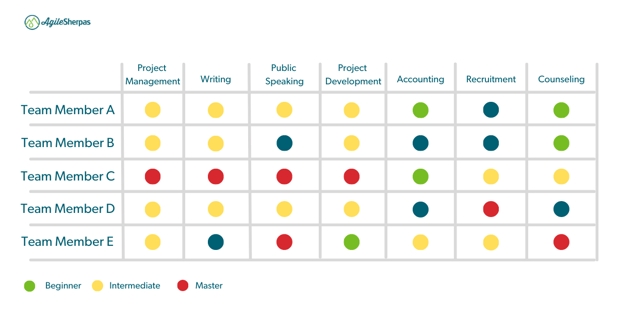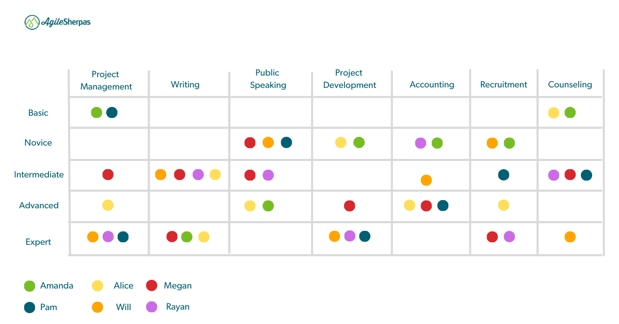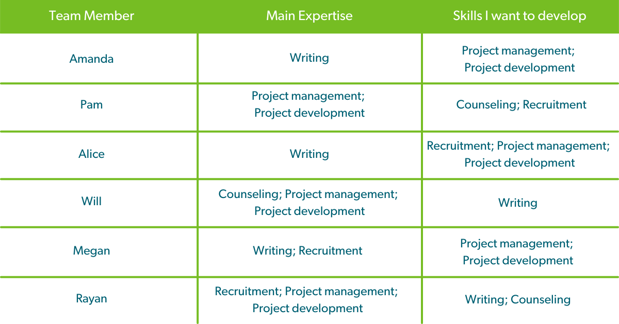When organizations set out on their Agile journeys, it’s because they see Agile as a remedy to the process problems that hold them back.
Some are hoping to improve productivity, others are aiming to enhance their ability to manage changing priorities or striving for better innovation capabilities within the team.
Unfortunately, when building an Agile team for any of those purposes, too many organizations become hyper-focused on the Agile practices and tools. As a result, they forget the foundation that turns a group of people into an Agile team: members with different functional expertise working toward a common goal.
Cross-functionality is one of the key traits of high-performing Agile teams. It gives them the ability to reduce external handoffs and improves flexibility when collaborating as a unit.
To achieve and sustain cross-functionality, marketers can apply a simple exercise from the HR playbook called skill mapping. Here's how it works.
What is an Agile Team
In a marketing context, an Agile team is a group of 4 to 10 people working together towards achieving common organizational business goals while embracing the values and principles from the Agile Marketing Manifesto.
By the way, we’ve gone one step further — updating the manifesto into The Agile Marketing Credo, a reset and a compass to help teams thrive in today’s fast-changing world.
In the ideal case, this group would be set up in a cross-functional way, bringing all the right people together to deliver certain types of marketing programs from start to finish autonomously.
The roles and responsibilities within the Agile team may vary depending on its needs and the chosen framework for achieving and sustaining marketing agility. For example, when applying Scrum, an Agile team would bring together a Marketing Owner, who's responsible for ensuring that the marketing collateral that gets delivered meets the organizational requirements, and individual contributors, who perform various marketing activities like copywriting, graphic design, data analysis, etc.
Team members should be 100% dedicated to their Agile team and only work on activities that are getting executed within the unit
Even though cross-functionality is not a mandatory condition for creating an Agile team (yes, functional teams can be Agile too), it makes it significantly easier to deliver more complex marketing programs without getting bogged down by dependencies from outside the team.
To operate effectively, Agile teams with experts from different areas are continually focused on expanding their individual skill sets, so that they can help progress projects and jump in where an extra pair of hands are needed. The more cross-functional the Agile team, the more flexibility they can distribute their resources, and, therefore, finish projects at a faster pace.
This is where skill mapping comes into play.
What is Skill Mapping
Skill mapping is a practice derivative of the HR toolkit, but marketers can use it too. It allows teams to visualize the skills they have available to them within their Agile marketing team and determine if their current capabilities fall short of their current or upcoming needs.
By creating a skill map, we can easily compare what each member of the team brings to the table and where our team may need to advance its capabilities. Having an accurate understanding of the team’s skills can help us prepare for any foreseeable challenges, and showcase where we need further strengthening by either upskilling our current team members or attracting reinforcements.
But this is just the tip of the iceberg.
Benefits of Аpplying Skill Мapping Within an Agile Тeam
Implementing skill mapping provides clarity by visually showcasing the available skills within the team in an easy-to-understand way. This comes with several important benefits.
First of all, it brings our attention to the skills that are the most scarce within the team.
Even if we seek complete cross-functionality, there are always going to be skills that are in higher demand than others. Skill mapping allows us to pinpoint them and plan our future work in a way that will ensure that we have these skills available at the times we need them most.
Another significant benefit of applying this practice is that the visualization we create highlights who on the team could benefit from additional training. A skill map gives us the ability to make a data-driven case to management for securing educational programs and workshops for individuals on the team.
Also, skill mapping provides a comprehensive insight into the actual distribution of competencies within the Agile team. Specifically, it showcases who falls under the category of a specialist or a generalist. Knowing this makes it easier to navigate the experts in the team, so new team members or someone looking to advance their knowledge in this area can turn to them.
Last but not least, if a team member leaves our organization, we can use the gap left in the skill map to define a perfect candidate profile to fill the opening in the Agile team.
Now that we know why it’s worth implementing, let’s explore the actual process of applying skill mapping.
How to Apply Skill Mapping
The primary tool that we’ll need to get started with skill mapping is called a skill matrix and it will look different for every team.

The skill matrix visualizes the skills that the Agile team needs to complete its assignments and maps them to each person.
Visualize the name of each person on the team on the X-axis and bring the team together to ideate around which skills should populate the Y-axis. To populate the Y-axis, ask leading questions like:
- What skills do we currently lean on within this team?
- What upcoming projects do we anticipate coming down the pipeline? Will we need to rely on specific skills for these?
- What skills do we anticipate becoming more important?
Then, ask each team member to fill out their skill proficiency for each skill listed on the Y-axis. Do this together in a dedicated meeting or share the matrix with the team and ask each person to fill in their competencies.
- Use a numeric value for skill mastery (e.g. 1 for beginner, 2 for intermediate, 3 for master)
- Apply different color indicators (e.g. green for beginner, yellow for intermediate, red for master)
- Draw pie charts (e.g. an empty circle for beginner, half-full circle for intermediate, full circle for master)
Depending on the team, some members might rate themselves much lower than how others view them within the team. Ask team members to rate themselves individually, but then bring the conversation together.
In the end, the skill map should reflect the skills in the team relative to the average understanding within the unit.
How We Do Skill Mapping
At AgileSherpas, we've developed a couple of templates that we use when introducing skill mapping inside teams who want to behave more cross-functionally in the future.

The first one consists of a horizontal axis that showcases the skills the team prioritizes and a vertical one that showcases the level of proficiency. All team members are visualized in a legend next to the matrix with different colored dots.
Each person adds their distinctive color indicator in the areas of the matrix that represent their proficiency best.

The second template that we recommend using as a follow-up is more focused on skill development – the more actionable cousin of skill mapping – relative to main expertise.
Based on the skill matrix, team members can prioritize where they believe they need to up-skill and get consensus from the team on each member’s development path.
Before We Start Mapping Team Skill
Ready to skill map with your Agile team? Make sure your team is ready, too.
The easiest way to get started is by sharing this article with your team members to prepare them for this practice theoretically.
After everyone has a shared understanding of what it means to be an even more successful Agile team, it becomes significantly easier to introduce skill mapping and explain the benefits of applying it.
More broadly, making sure they have a shared understanding of the benefits of cross-functionality in an Agile setting will mean they are coming to the skill mapping workshop with an open mind and motivation.
Skill mapping can be a wonderful tool of empowerment, where teams have a chance to take control of their learning journeys and be proactive about where they want to develop their skills in the future to move the team forward.
Before you move on, why don't you take a second to check if bad processes are eating up your marketing budget?